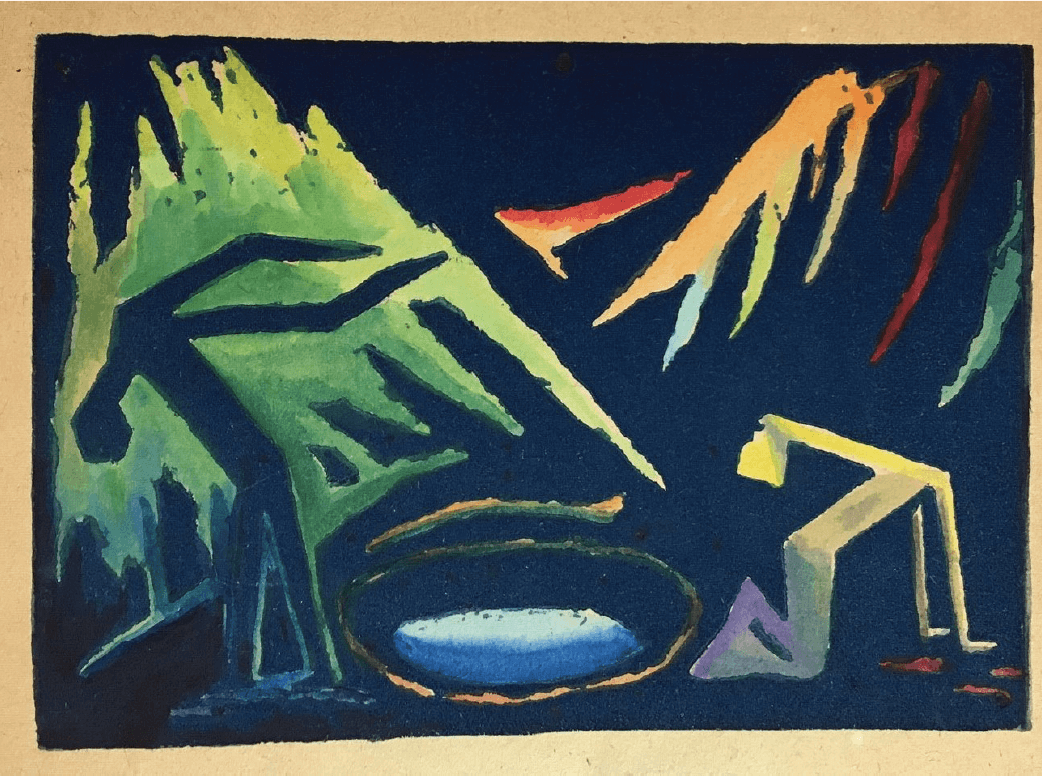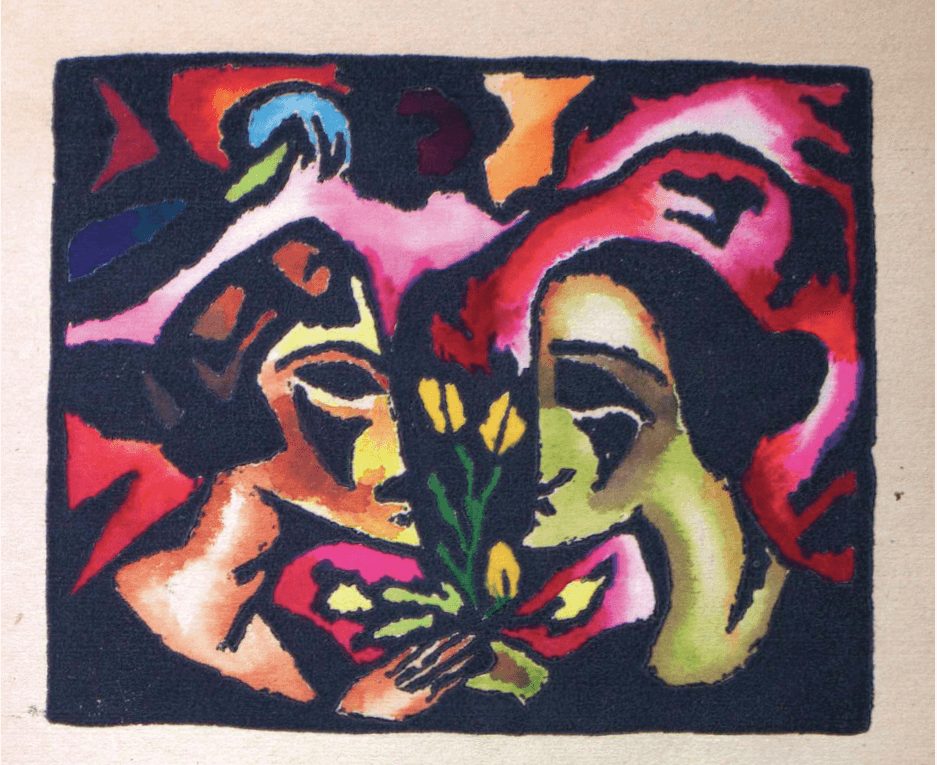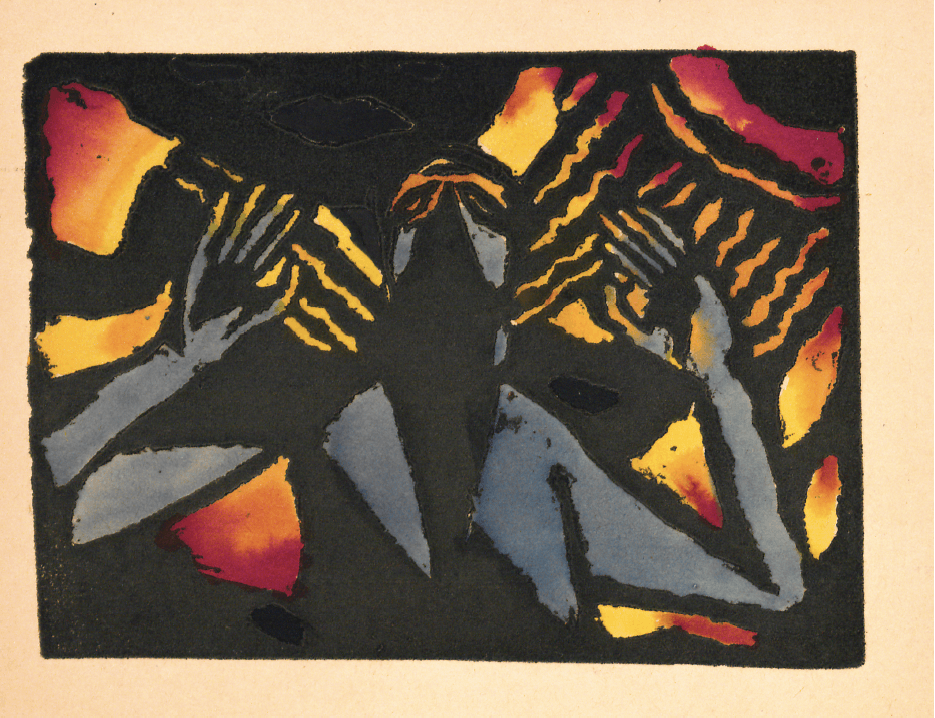Above: Detail from Archie Rand. 326: To Send the Impure from the Temple (Numbers 5:2), 2001-2006. From the series The 613. Acrylic on canvas. 20 x 16 in. Photo by Samantha Baskind
Scholars Insights on Art
Two years ago, I was browsing donated books at my workplace, the Yiddish Book Center, when a bright illustration caught my eye (fig. 1). Against a dark sky lit up by lightning flashes, two androgynous yellow-blue figures writhe like puppets beside a pool. I turned the book over and saw a Yiddish title page—Himlen in opgrunt [Heavens in the Abyss], by Chaim Krol, with illustrations by Esther Karp. The book was incomplete, extremely fragile, and utterly intriguing. That chance encounter soon turned into an obsessive quest. It led me to libraries and archives on three continents, a scholarly conference in Poland, and a growing conviction that the book I had chanced upon was a crucial missing piece of a wider story: the forgotten women artists of Jewish, and especially Yiddish, modernism.

Fig. 1. Illustration by Ester Karp for Chaim Krol’s Himlen in opgrunt (Lodz, Farlag Achrid, 1921).
The first clue to the significance of the book I had found was the name of its publisher, Farlag Achrid. WorldCat showed just three titles under that imprint, all published in Lodz in 1921. Each slim volume of poetry—two in Yiddish, one in German—was illustrated by a woman artist: Ida Broyner, Ester Karp, or Dina Matus. A total of fifteen surviving copies were listed, and by the time the pandemic struck, I had seen eight of them, starting with the copies at Wellesley College and the Library of Congress. What I found stunned me. Every book was a unique work of art, printed, then hand-finished with its own color palette. A woman’s neck was pale in one copy, bruised with purple blotches in another. Water was blue, then iridescent. A strange bird, like an overweight pterodactyl, assumed multiple psychedelic guises. The luminous color illustrations were powerful, haunting, and hypnotic. It seemed clear to me that I was looking at a blazing masterpiece of Polish Jewish expressionism, but references to the books were almost nonexistent.
Every book was a unique work of art, printed, then hand-finished with its own color palette.

Fig. 2. Illustration by Dina Matus for Rachel Lipstein’s Zwischen dem Abend und Morgenrot (Lodz, Farlag Achrid, 1921).
Broyner, Karp, and Matus came together to create these extraordinary works on the fringes of Yung Yidish, a loose circle of avant-garde artists, writers, and theater folk in post–World War I Lodz. At the time, and ever since, the most celebrated figures in the group were Yankel Adler, Moyshe Broderzon, and Marek Szwarc. Women were present in Yung Yidish but men predominated, especially as contributors to its journals. In sharp contrast, the Farlag Achrid project has a clear feminist orientation and energy. Its organizer and inspirational force appears to have been Rachel Lipstein, a poet whose apocalyptic German text Zwischen dem Abend und Morgenrot [Between Dusk and Dawn] was illustrated by Dina Matus, a close friend. While Broyner stayed in Lodz, and Karp moved to Paris, Lipstein and Matus were at the center of a coterie of radical Polish Jewish women who moved on from Lodz to Berlin and then, in some cases, to Moscow.
Other Jewish women artists created outstanding avantgarde books, of course, including Sarah Shor, Sonia Delaunay, and Teresa Zharnover. But the Farlag Achrid titles—a trio of coordinated, complementary illustrated books showcasing the work of overlooked women artists as printmakers, calligraphers, and painters—stand alone. Its very name—Achrid —can be seen as a one-word manifesto. Lipstein was fluent in Hebrew, among many other languages, and the choice of this biblical word, carrying a promise of earth-shaking upheaval, is surely at once political, artistic, and personal.
.
Fig. 3. Illustration by Ida Broyner for Dovid Zitman’s Af vaytkeytn krayznde fal ikh (Lodz, Farlag Achrid, 1921).
At the time they created these works, Broyner, Karp, Matus, and Lipstein were still in their twenties and must have felt the world was theirs for the shaking. All found success, but fate has not been kind to their memory. It is little exaggeration to say that all three artists were crushed by the Holocaust, although only Dina Matus perished in it. Karp, known in France as Esther Carp, succumbed to devastating bouts of mental illness. Broyner’s health was also profoundly damaged. In addition, the war swept away almost everything Broyner and Matus had ever created. In a profound sense, the Farlag Achrid trilogy is their collective matseyve (monument).
Two years ago, when I began researching these books, none of the librarians I met had ever opened them.
Two years ago, when I began researching these books, none of the librarians I met had ever opened them. Without exception, all were amazed at what they were seeing. Now, a century after the books’ publication, word is finally getting out. In France and Poland, there are plans for exhibitions, facsimile editions, and more. Rebalancing the Jewish modernist canon to give women artists their due is a work in progress. It’s one in which Broyner, Karp, and Matus deserve to play an honored part.

DAVID MAZOWER is research bibliographer and editorial director at the Yiddish Book Center in Amherst, Massachusetts. His most recent article is “Farlag Achrid - A Bibliographic Note,” for a bilingual volume forthcoming from Lodz University Press about the three artists’ books of Farlag Achrid and the Jewish Avant-Garde in Lodz.